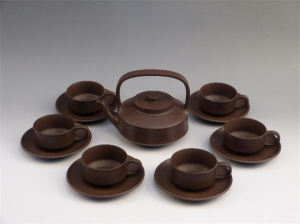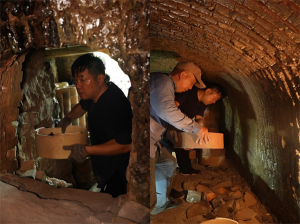Dingshu: Reviving Ancient Ceramics for the Future of Cultural Heritage
JIANGSU, CHINA, May 30, 2025 /EINPresswire.com/ -- Recently, as China celebrates its Cultural and Natural Heritage Day, Dingshu, the renowned "Pottery Capital," stands as a beacon of tradition and innovation. Nestled in the serene water towns of southern China, Dingshu is home to centuries-old purple clay artistry, where earth is transformed into masterpieces in the iconic dragon kilns. With its deep-rooted ceramic heritage and thriving modern influences, Dingshu blends past and future, offering a glimpse into how ancient craftsmanship can adapt to today’s global stage.
I. Soul of Purple Clay: Earth Reborn, Unrivaled Mastery
Dingshu’s purple clay teapots, hailed as “treasures among ceramics,” owe their excellence to a perfect marriage of unique local clay and human ingenuity. The mineral-rich purple clay from Huanglong Mountain, fine-textured and iron-dense, emerges from firing with elegant hues and exceptional breathability—keeping tea fresh overnight and earning its title as “the finest tea vessel on earth.”
Crafting each teapot is a dialogue with time. From mining and clay refining to shaping, carving, and firing, dozens of steps demand unwavering focus. Artisans mold nature’s beauty into miniature worlds, their hands like brushes painting with clay. The Ming-dynasty GongChun Teapot epitomizes this art—its gnarled trunk-like body and lifelike peach-blossom lid pioneered the “naturally transcendent” aesthetic. Today, masters like 88-year-old Xu Xiutang, a National Intangible Cultural Heritage bearer and China’s Master of Arts and Crafts, still shape miracles from earth daily, captivating collectors worldwide.
II. Dragon Kiln: Millennial Flames, Eternal Craft
If purple clay is Dingshu’s soul, the Qianchu Dragon Kiln is its forge. Built along a slope during the Ming Dynasty, this 43-meter-long kiln, resembling a coiled dragon, has burned pine wood for six centuries using ancient wood-firing techniques. Each Lunar New Year, Dragon Boat Festival, and Mid-Autumn Festival, its opening becomes a sacred rite. On the fifth day of the first lunar month in 2025, the Year of the Snake’s “first firing” commenced with drums and gongs. Teapots and ceramics emerged, glazed and glowing like time-traveling envoys whispering of a “millennial pact between clay and fire.”
The kiln opening is both ritual and celebration. Dragon dances, blessings from the God of Wealth, and artisan markets draw crowds. Visitors add firewood for luck or take home limited-edition crafts, immersing in the “Dragon Kiln New Year” festivity. Beyond preserving tradition, the kiln fuels rural revitalization—powering pottery, logistics, and tourism, proving ancient crafts can thrive anew.
III. Pottery Living: Blending Eras, Cultural Renaissance
In Dingshu, pottery transcends objecthood to become a philosophy. Along Shushan Ancient South Street—lined with Ming-Qing buildings beside the murmuring Li River—purple clay was born and masters nurtured. Avoiding demolition, the street’s “gradual renewal approach” preserves authenticity: old houses now host teahouses and studios where artisans craft pots while sipping tea with visitors, fusing heritage with modernity.
The repurposed Ceramic Factory No. 2 epitomizes this fusion. Its UCCA Tao Art Museum, designed by Kengo Kuma with dragon-kiln-inspired brickwork, ranks among the world’s architectural marvels. Interwoven with cafés, digital exhibits, and craft markets, it draws youth alongside apprentices—a “Huangpu Military Academy for purple clay” and Yixing’s cultural salon to the world.
Dingshu’s cultural map expands further: the Huanglong Mountain Clay Park turns mines into art spaces; Zhongchao Liyong Creative Park offers industrial tourism; Dongpo Academy links poetry and pottery. In 2024, Dingshu welcomed over 2.6 million visitors—with May Day 2025 surges signaling booming appeal. Now, “pottery living” radiates globally via livestreams, art festivals, and e-commerce.
IV. Global Pottery Capital: Open Doors, Boundless Future
Dingshu’s global journey began with purple clay but now transcends it. Xiwang Village, certified by the UN as an “International Teapot Art Village,” hosts residencies with global ceramists. Masters like Gu Meiqun and Fan Weiqun exhibit worldwide. The Taoer Residency Program draws international artists, sparking dialogues between purple clay and contemporary art. Even Burberry, enchanted by its legacy, held a gala in the Tao Art Museum.
Today, Dingshu is both a sanctuary for tradition and an innovation hub. The Wood-Stone Digital Industrial Park hosts 3,500+ e-commerce vendors, with purple clay sales exceeding 1 billiot online this year. Emerging sectors—general aviation ecosystems and advanced ceramic materials—propel the ancient town into a “land-water-air” future.
Epilogue: Eternal Artistry, Everlasting Rhyme
In Dingshu, every teapot is a slice of history; every dragon kiln, a totem of civilization; every lane, a poetic ode to life. This is a tale of earth reborn, fire worshiped, and craftsmanship preserved—and how a small town sails the world on culture’s currents. Sip tea here by a murmuring pot, and feel the breath of a millennia-old pottery capital: Yixing Dingshu, where the world comes to understand China.
Jiang Qian
Da Mei Ding Shu Characteristic Town Cultural Tourism
email us here
Legal Disclaimer:
EIN Presswire provides this news content "as is" without warranty of any kind. We do not accept any responsibility or liability for the accuracy, content, images, videos, licenses, completeness, legality, or reliability of the information contained in this article. If you have any complaints or copyright issues related to this article, kindly contact the author above.



